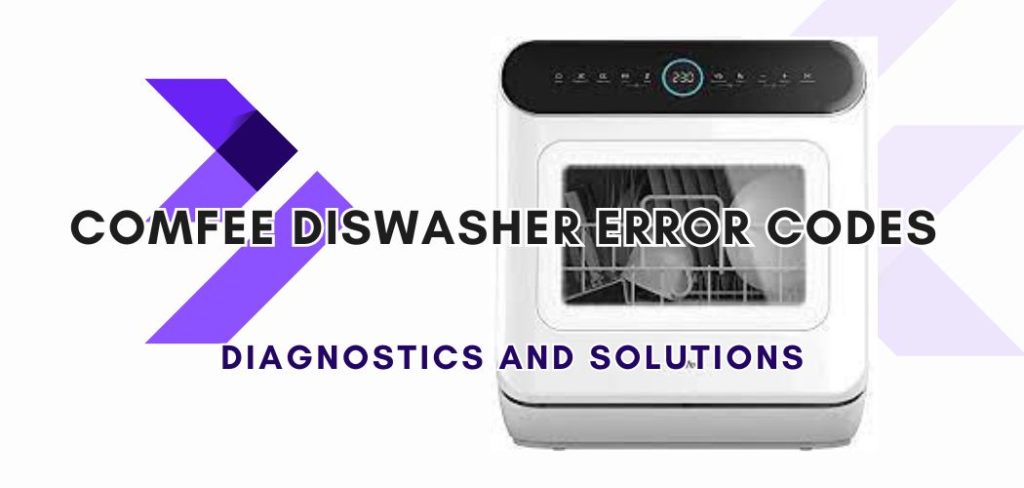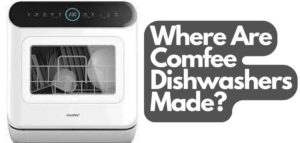When your Comfee dishwasher displays an error code, it can disrupt your routine and cause frustration.
Understanding these error codes is essential for troubleshooting and maintaining your appliance effectively.
This guide will clarify the common error codes associated with Comfee dishwashers, helping you resolve issues quickly.
Each error code indicates specific problems, ranging from minor inconveniences to more serious malfunctions.
Knowing what these codes mean can help you take appropriate action to fix the issue or determine if professional assistance is needed.
Read on to explore the meanings behind each error code, which will empower you to manage your appliance with confidence and ease.
With the right knowledge, you’ll reduce downtime and keep your dishwasher running smoothly.
Table of Contents
Understanding Comfee Dishwasher Error Codes:
Error codes on your Comfee dishwasher serve essential functions. They indicate specific issues, helping you understand what needs attention.
Identifying these codes allows for efficient troubleshooting, ensuring your appliance runs smoothly.
The Purpose of Error Codes:
Error codes are designed to communicate specific problems within your dishwasher’s operation. Each code corresponds to a malfunction or irregularity in the system.
For example, Error Code E1 usually indicates a water supply issue, while Error Code E2 often points to a drainage problem.
Recognizing these codes helps you quickly identify potential issues.
This functionality prevents unnecessary repairs. Instead of fumbling around with guesswork, these codes direct you to the precise problem.
This clarity saves time and reduces frustration, allowing you to respond accordingly.
How Error Codes Help in Troubleshooting:
When you encounter a code, refer to the user manual for specific guidance related to that error.
Often, the solution may be as simple as checking a clogged filter or ensuring the water supply valve is open.
Using the information these codes provide, you can take actionable steps. For instance, if experiencing a drainage error, you might inspect the drain hose for blockages.
By following the instructions associated with each code, you can resolve issues without needing a service technician, leading to cost savings and a more efficient appliance.
Common Error Codes and Solutions:
Understanding the common error codes of your Comfee dishwasher can simplify troubleshooting.
This section highlights typical issues and their respective solutions, enabling you to efficiently manage malfunctions.
Water Filling Issues:
Water filling errors often arise from obstructions in the water supply, faulty inlet valves, or issues with the float switch.
If you encounter an error indicating a filling problem, first check the water supply.
- Inspect the Hose: Ensure the water inlet hose is not kinked or blocked.
- Valve Functionality: Test the inlet valve for proper operation. If it’s stuck or faulty, replacing it may be necessary.
- Float Switch: Check the float switch for debris. Clean it if needed, as a stuck float can falsely indicate that water is filling.
Drainage Problems:
Drainage errors can prevent your dishwasher from emptying water effectively, leading to potential overflow issues. Follow these steps to address drainage problems.
- Check the Drain Hose: Ensure the drain hose is free from kinks and is at the correct height to facilitate drainage.
- Filter Inspection: Remove and clean the filter located at the bottom of the dishwasher. Clogs can significantly impact drainage efficiency.
- Pump Functionality: Listen for the drain pump. If it’s not operating, it may need repair or replacement.
Taking these steps should help resolve most drainage issues.
Heating Errors:
Heating errors indicate that the dishwasher is not reaching the required water temperature. This can impact cleaning performance.
If you observe a heating error, consider the following troubleshooting steps.
- Examine the Heating Element: Inspect the heating element for any visible damage or corrosion. This could indicate a need for replacement.
- Thermostat Check: Check the thermostat for proper operation. If it is malfunctioning, it may prevent the heating element from turning on.
- Wiring Issues: Inspect the wiring for any loose connections that could interrupt the heating process.
Addressing these common problems can restore proper heating functionality.
Door Latch Errors:
Door latch errors occur when the dishwasher cannot detect if the door is securely closed. This can disrupt the entire washing cycle. Here’s how to tackle door latch issues.
- Inspect the Latch Mechanism: Check to see if the latch is functioning properly. A faulty latch may not engage, prompting an error.
- Alignment Check: Ensure that the door is properly aligned with the latch. Misalignment can prevent a secure closure.
- Electrical Connection: Inspect the electrical connections linked to the door latch. Loose or damaged wiring can interfere with proper operation.
Error Code Indicators:
Understanding the error codes on your Comfee dishwasher is crucial for efficient troubleshooting.
You will encounter various signals, including alphanumeric codes, LED sequences, and alarm sounds that directly inform you about the status of your appliance.
Alphanumeric Codes:
Alphanumeric error codes are displayed on the dishwasher’s control panel. Each code corresponds to a specific issue, such as drainage problems or heating failures.
| Error Code | Description |
| E1 | Water leakage detected |
| E2 | Heating element failure |
| E3 | Water will not drain |
| E4 | Overflow condition |
Refer to your manual to find the specific meanings behind these codes. Knowing what each code indicates allows you to take the appropriate action quickly.
LED Sequences and Flash Patterns:
LED indicators often provide visual cues about the dishwasher’s operation status. For instance, a steady LED light typically means the appliance is running correctly.
A series of quick flashes or a blinking light often indicates an error. Flash patterns can vary in meaning:
- 1 Flash: Low water level
- 2 Flashes: Door not securely closed
- 3 Flashes: Machine overload
Consult your user manual for the precise meanings of LED sequences. Observing these patterns helps identify issues without needing to decode complex messages.
Sounds and Alarm Tones:
Sound alerts from your dishwasher serve as additional indicators of malfunctions. Different tones signal distinct errors or status updates.
- Single beep: Cycle completed successfully
- Double beep: Error detected, requires attention
- Continuous alarm: Critical failure, such as a blockage
Listening to these sounds heightens your awareness of the machine’s condition. This knowledge enables you to react promptly to resolve any issues that arise during operation.
Troubleshooting Steps:
When encountering error codes on your Comfee dishwasher, it’s important to follow systematic troubleshooting steps to identify and resolve the issue.
This guide will help you assess the situation, perform necessary resets, check for manual issues, and decide when to seek professional help.
Initial Assessment:
Begin by performing a general inspection of your dishwasher. Check the display panel for any visible error codes that can guide you.
Make sure the door is completely closed and latched. A partially open door can trigger an error code.
Inspect the power supply; ensure the dishwasher is plugged in and that the outlet is functioning. If you notice any unusual sounds or leaks, take note of them, as they can indicate specific problems.
Document any flashing lights or beeping noises as these can provide insight into the issue’s nature.
Resetting the Dishwasher:
Resetting your Comfee dishwasher can often clear minor errors. To reset, unplug the unit from the electrical outlet. Wait for at least 5 minutes before plugging it back in. This process can help reset the electronic control board.
Alternatively, many models have a reset button. Refer to your user manual for the exact location and method.
After resetting, run a short cycle to see if the error code reappears. If it does, further inspection and troubleshooting steps are needed.
Manual Checks:
Performing manual checks can reveal issues not visible through error codes. Start by inspecting the filters.
A clogged filter can cause operational problems. Clean them under running water to ensure they are free from debris.
Next, examine the spray arms. Ensure they are not blocked by any obstructions. You should also check the hoses for kinks or blockages, as these can affect water drainage and pressure.
Testing the water inlet valve for proper functioning may reveal additional issues; if it’s stuck, it may need replacement.
Seeking Professional Assistance:
If your troubleshooting efforts do not resolve the error, it may be time to seek professional assistance.
Contact a qualified technician who understands your specific model. Ensure that they are familiar with common error codes associated with Comfee dishwashers.
Prepare a detailed description of the problem, including any error codes, sounds, or behaviors you’ve noticed.
Providing this information can help the technician diagnose the issue more quickly.
Consider checking warranties or service plans that may cover repairs for your unit, as this can alleviate some of the costs associated with professional services.
Maintenance Tips to Avoid Common Errors:
Proper maintenance can significantly reduce the occurrence of error codes in your Comfee dishwasher.
Routine Cleaning:
Regular cleaning of your dishwasher is essential for optimal performance. Start by wiping down the interior surfaces with a damp cloth to remove food particles and grime.
Pay special attention to the door seals and rubber gaskets, as debris can cause leaks and errors.
Empty the filter located at the bottom of the appliance. Rinse it thoroughly under running water, ensuring there are no blockages. A clogged filter can lead to improper drainage and trigger error codes.
Also, clean the spray arms. Remove them if necessary, and rinse under water to eliminate any obstructions that may impair water flow.
Keeping these components clean will prevent common errors related to drainage and cleaning performance.
Periodic Inspections:
Schedule periodic inspections to ensure all parts of your dishwasher are functioning correctly. Check the water inlet valve for any signs of wear or leaks.
A malfunctioning valve can result in error codes related to inadequate water supply.
Inspect hoses for kinks or cracks that could restrict water flow. Ensure they are securely connected to both the dishwasher and the water source.
Replacing damaged hoses can prevent errors arising from water supply issues.
Additionally, verify the electrical connections. Loose or damaged wiring can lead to operational failures. A quick visual inspection can help you catch these problems before they escalate.
Replacement of Wearable Parts:
Replace wearable parts promptly to prevent disruptions in your dishwasher’s operations. Pay attention to the filter, spray arms, and door seals, as these components can wear out over time.
The filter typically requires replacement every 6 to 12 months, depending on usage. Inspect the spray arms for cracks or blockages and replace them if necessary.
Door seals should also be checked regularly for signs of wear, which can lead to leaks. If you notice any cracks or deterioration, replacing the seals promptly will help prevent error codes related to drainage and water leakage.
Conclusion:
Understanding the error codes of your Comfee dishwasher can significantly enhance your troubleshooting efforts. Each code serves as a diagnostic tool, guiding you to identify issues quickly.
Being proactive can prevent larger problems. If an error persists, consider reaching out to customer support for further assistance.
By recognizing these error codes and acting on them promptly, you ensure your dishwasher operates efficiently, extending its lifespan and reliability.




